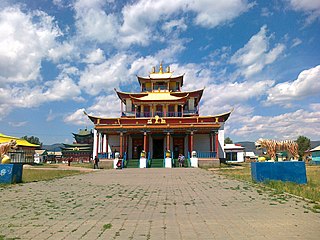
The Buryats are a Mongolic ethnic group native to southeastern Siberia who speak the Buryat language. They are one of the two largest indigenous groups in Siberia, the other being the Yakuts. The majority of the Buryats today live in their titular homeland, the Republic of Buryatia, a federal subject of Russia which sprawls along the southern coast and partially straddles Lake Baikal. Smaller groups of Buryats also inhabit Ust-Orda Buryat Okrug and the Agin-Buryat Okrug which are to the west and east of Buryatia respectively as well as northeastern Mongolia and Inner Mongolia, China. They traditionally formed the major northern subgroup of the Mongols.

Ulan-Ude is the capital city of Buryatia, Russia, located about 100 kilometers (62 mi) southeast of Lake Baikal on the Uda River at its confluence with the Selenga. According to the 2021 Census, 437,565 people lived in Ulan-Ude; up from 404,426 recorded in the 2010 Census, making the city the third-largest in the Russian Far East by population.

Buryatia, officially the Republic of Buryatia, is a republic of Russia located in the Russian Far East. Formerly part of the Siberian Federal District, it has been administered as part of the Far Eastern Federal District since 2018. Its capital is the city of Ulan-Ude. It has an area of 351,300 square kilometers (135,600 sq mi) with a population of 978,588. It is home to the indigenous Buryats.
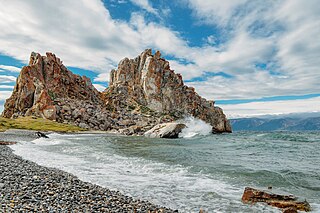
Olkhon is the third-largest lake island in the world. It is by far the largest island in Lake Baikal in eastern Siberia, with an area of 730 km2 (280 sq mi). Structurally, it constitutes the southwestern margin of the Academician Ridge. The island measures 71.5 km (44.4 mi) in length and 20.8 km (12.9 mi) in width.
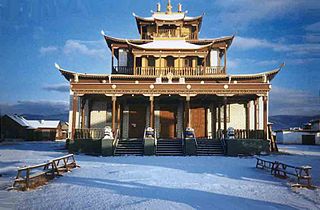
Datsan is the term used for Buddhist university monasteries in the Tibetan tradition of Gelukpa located throughout Mongolia, Tibet and Siberia. As a rule, in a datsan there are two departments—philosophical and medical. Sometimes to them is added the department of the tantric practices where the monks study only after finishing education in the philosophical department.

Severobaikalsk is a town in the Republic of Buryatia, Russia, located on the northern end of Lake Baikal at the mouth of the Tyya River, 440 kilometers (270 mi) northwest of Ulan-Ude and 490 kilometers (300 mi) northeast of Irkutsk. Population: 24,929 (2010 Census);
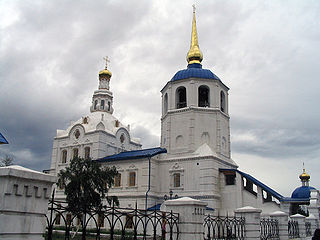
St. Odigitrievsky Cathedral is an Orthodox church, a monument of architecture of the Siberian Baroque of the middle of the XVIII century in Transbaikalia. It was built in 1741–1785 in the city of Verkhneudinsk

The Winter Palace of the Bogd Khan, or the Bogd Khan Palace Museum, is a museum complex located in Ulaanbaatar, Mongolia. It was part of larger complex called the "Green Palace", an imperial residence of the eighth Jebtsundamba Khutughtu, who was later proclaimed Bogd Khan, or ruler of Mongolia. Alongside being the oldest museum, it is also considered as one with the biggest collection in Mongolia. The palace is the only one left from originally four residences of the Bogd Khan.
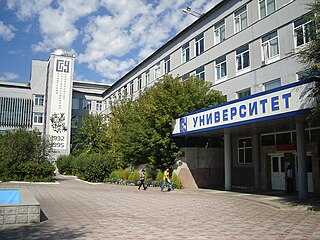
Buryat State University is an institution of higher education in Siberia and the Russian Far East, located in the city of Ulan-Ude, Buryat Republic, Russia. Courses are taught in Russian and Buryat. It was established in 1932 as the Buryat State Teachers' Training College, and became a university in 1995. It is a member of the University of the Arctic.
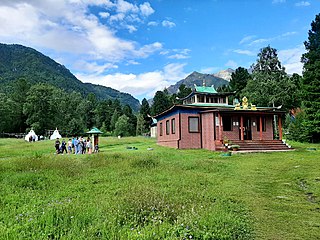
Arshan is a small resort village in the Tunkinsky District, Republic of Buryatia, Russian Federation. It is known for its mineral waters, spa, and the Khoymorski Datsan Boddhidharma Tibetan Buddhist temple. The name comes from the Buryat word for "spring."
Buddhism in Buryatia—a regional form of Buddhism.

Dashinima (Dashi) Balzhanovich Namdakov is a Russian sculptor and artist, an indigenous Siberian, and a member of the Russian Union of Artists.

Baikal International Airport, formerly Ulan-Ude Airport is an international airport located 12 kilometres (7.5 mi) west of Ulan-Ude, Russia. The airport has two terminals with customs and border control facilities with a capacity of 400 passengers per hour. In 2021, the airport served 540,094 passengers on more than 20 scheduled international and domestic destinations. The airport is named after the nearby Lake Baikal.

Damba Badmaevich Ayusheev —the XXIV Pandito Khambo Lama—a Head of the Buddhist Traditional Sangkha of Russia.

Bortoi is a village in the Zakamensky district of Buryatia, Russia.

Dorzhi Banzarov was a Buryat Orientalist and linguist, notable for being the first person of non-ethnic Russian descent to receive a Ph.D. at a Russian university. He is generally considered to be the first Buryat academic.

Bernhard Eduardovich Petri was a Russian anthropologist and archaeologist. Petri organized archeology and ethnographic expeditions to Lake Baikal, while employed by the Kunstkamera during the 1910s.
The 103rd Rocket Red Banner, Orders of Kutuzov and Bohdan Khmelnytskyi Brigade, is a tactical surface-to-surface missile formation of the Ground Forces of the Russian Federation. Its Military Unit Number is 47130. It is equipped with the 9K720 Iskander tactical ballistic missile.






